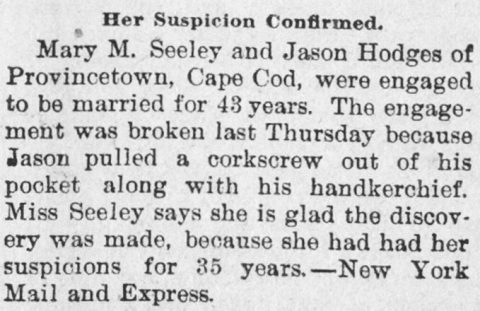In 1785, the London press became fascinated by the antics of Harriet Errington, uncovered at divorce proceedings instigated by her wealthy businessman husband. Mrs Errington was accused of numerous counts of adultery. Among those listed as her lovers were “Augustus Murray Smith, Captain Buckley, Captain Southby, Thomas Walker, and many others”.
In one whimsical account of the testimony, Mrs Errington was visited for dinner by Captain Southby, but according to maidservant Molly Mitchell, the Captain and Mrs Errington abandoned their food and went upstairs:
“We cannot absolutely say how she was engaged while the repast was cooling… The Captain and she, it is supposed, were taking a wet and relish together; or he might probably be instructing her in… the modern methods of attack and defence. She is a woman who thirsted after knowledge and if the Captain had anything new to communicate, she was sure to pump it out of him… Molly Mitchell supposes the Captain discharged his musket, for though she did not hear the report, she smelt the powder…”
Even more shocking to London society was Mrs Errington’s lewd dealings with working class men and servants. Simon Orchard, a teenage footman, testified that while asleep in his bed:
“..he was waked by the bedclothes being stripped off him, and upon looking he observed the said Harriet Errington, in her shift only… and Phebe Lush, a fellow servant, by his bedside. And the said Harriet Errington pulled up his shirt and caught hold of his private parts, and pulled him out of bed by the same, and said she would pull him down the stairs… This deponent struggled a good deal with her to get away.”
Mrs Errington’s approaches continued the following night, when she ordered Simon to hide under the bed of a female servant, in order to spy her undressing. On the third day, Orchard walked in on Mrs Errington trimming her pubic hair, before a small crowd of onlookers:
“As this deponent was going into the kitchen, this deponent saw the said Harriet Errington standing before the fire, with her petticoats as high as her knees… Phebe Lush and Mary Mitchell and her master’s son, a boy about five years old, were with her… Seeing some small pieces of hair laying upon paper, [Orchard] asked what it was, and the little boy told him, that Mrs Errington had been cutting it off under her petticoats…”
The London court granted George Errington a divorce without hesitation. In 1795 George was murdered by one of his own spurned lovers, Miss Ann Broderick, who shot him through the heart. The fate of the former Mrs Errington is unknown.
Source: Various, inc. Randall, The Trial of Mrs Harriet Errington, London, 1785. Content on this page is © Alpha History 2019-23. Content may not be republished without our express permission. For more information please refer to our Terms of Use or contact Alpha History.

